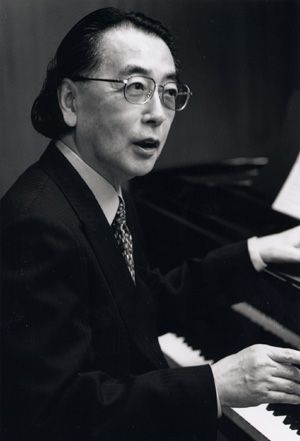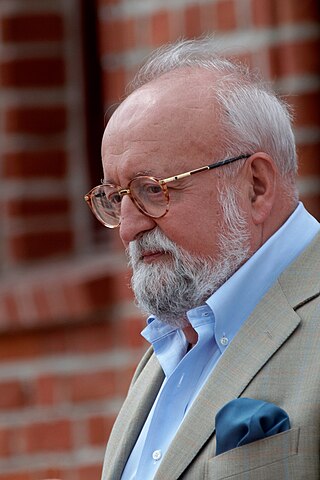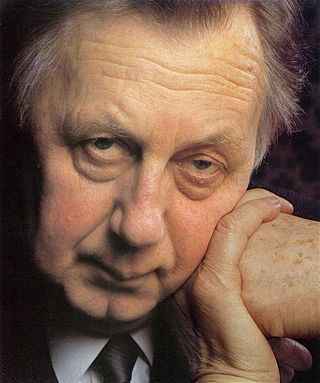Related Research Articles

Pēteris Vasks is a Latvian composer.

Toshi Ichiyanagi was a Japanese avant-garde composer and pianist. One of the leading composers in Japan during the postwar era, Ichiyanagi worked in a range of genres, composing Western-style operas and orchestral and chamber works, as well as compositions using traditional Japanese instruments. Ichiyanagi is known for incorporating avant-garde techniques into his works, such as chance music, extended technique, and nontraditional scoring. Ichiyanagi was married to artist Yoko Ono from 1956 to 1962.

Polish Requiem, also A Polish Requiem, is a large-scale requiem mass for soloists, mixed choir and orchestra by the Polish composer Krzysztof Penderecki. The Lacrimosa, dedicated to the trade union leader Lech Wałęsa, was written for the unveiling of a statue at the Gdańsk Shipyard to commemorate those killed in the Polish anti-government riots in 1970. He expanded the work into a requiem, writing other parts to honour different patriotic events over the next four years.
Roberto Sierra is a Puerto Rican composer of contemporary classical music.

Włodzimierz Kotoński was a Polish composer.
Miroslav Miletić (Croatian pronunciation:[mǐrɔlaʋmîlɛitɕ]; was a Croatian composer and a violin and viola player and teacher.
Onutė Narbutaitė is a Lithuanian composer.

The Symphony No. 3 is a symphony in five movements composed between 1988 and 1995 by Krzysztof Penderecki. It was commissioned and completed for the centenary of the Munich Philharmonic. Its earliest version, Passacaglia and Rondo, premiered at the International Music Festival Week in Lucerne, Switzerland, on August 20, 1988. It was performed by the Lucerne Festival Orchestra and conducted by Penderecki. The full symphony premiered in Munich on 8 December 1995, performed by the Munich Philharmonic, again conducted by the composer.

Polymorphia is a composition for 48 string instruments composed by the Polish composer Krzysztof Penderecki in 1961. The piece was commissioned by the North German Radio Hamburg. It premiered on 16 April 1962 by the radio orchestra and was conducted by Andrzej Markowski. Polymorphia is dedicated to Hermann Moeck, the first of Penderecki’s editors in the West.

Anaklasis is a composition for 42 string instruments and percussion, composed in 1960 by the Polish composer Krzysztof Penderecki. It was first performed at the Donaueschingen Festival in 1960. At this first performance, it was well received by the audience who demanded an encore.

The Suite is a composition for solo cello by Polish composer Krzysztof Penderecki. The piece is well known for its typical chromatic melodies and for its recurrent use of pizzicati and col legno.
The Partita for Harpsichord and Orchestra, sometimes also referred to as Partita for Harpsichord, Electric Guitar, Bass Guitar, Harp, Double Bass, and Chamber Orchestra or Harpsichord Concerto, is a composition by Polish composer Krzysztof Penderecki. It was finished in 1971 and is Penderecki's only major composition for a harpsichord soloist.

The Symphony No. 1 by Polish composer Krzysztof Penderecki was composed in 1973. It was published by Polish Music Publishing House and Schott Music and has never been expanded or revised.

The Dream of Jacob, also referred to as The Awakening of Jacob, is a composition by Polish composer Krzysztof Penderecki. It is scored for large orchestra and was finished in 1974.
Canticum Canticorum Salomonis is a choral composition by Polish composer Krzysztof Penderecki. It was finished in 1973.
The Clarinet Quartet, also known as Quartet for Clarinet and String Trio, is a work for clarinet, violin, viola, and cello by Polish composer Krzysztof Penderecki. It was finished in 1993.

Krzysztof Penderecki's setting of the biblical canticle Magnificat was commissioned for the 1,200th anniversary of Salzburg Cathedral and premiered there on 17 August 1974 under the composer's baton. It is a vast work, being scored for bass vocal soloist, boys’ voices, seven other men’s voices, two 24-part mixed choirs and orchestra.
The Percussion Concerto No. 2 is a concerto for solo percussion and orchestra by the Scottish composer James MacMillan. The work was jointly commissioned by the Netherlands Radio Philharmonic, the Philharmonia Orchestra, the Orchestre national du Capitole de Toulouse, the Cabrillo Festival of Contemporary Music, the Baltimore Symphony Orchestra, and the São Paulo State Symphony. It was first performed on November 7, 2014 at TivoliVredenburg in Utrecht, the Netherlands, by percussionist Colin Currie and the Netherlands Radio Philharmonic under conductor James Gaffigan. The composition is MacMillan's second percussion concerto after 1992's Veni, Veni, Emmanuel.
Marcel Chyrzyński is a Polish composer. He has been described as "a polystylist with an enormous sense of humour, and a lover of rhythm and jazz improvisation". Chyrzyński's works have been performed throughout Europe, as well as in South Korea, Australia, New Zealand, Japan, the USA and Canada.
References
- ↑ Penderecki, Krzysztof (1962). "Fonogrammi composer: Krzysztof Penderecki for flute and chamber orchestra". schott-music.com. Schott Music. Retrieved February 8, 2014.
- 1 2 3 "Blue" Gene Tyranny. "Krzysztof Penderecki – Fonogrammi, for flute & chamber orchestra". allmusic.com. Rovi Corporation. Retrieved February 8, 2014.
- ↑ Avis, Peter (2007). Penderecki: Orchestral Works. EMI Records Ltd.
- 1 2 Whitehouse, Richard. "PENDERECKI, K.: Fonogrammi / Horn Concerto / Partita / The Awakening of Jacob / Anaklasis / De natura sonoris No. 1 (Warsaw Philharmonic, Wit)". naxos.com. Naxos Digital Services. Retrieved February 9, 2014.